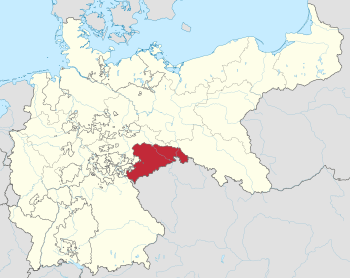Kingdom of Saxony facts for kids
Quick facts for kids
Kingdom of Saxony
Königreich Sachsen
|
|||||||||
|---|---|---|---|---|---|---|---|---|---|
| 1806–1918 | |||||||||
|
Anthem: Sachsen Hymne
|
|||||||||

Kingdom of Saxony within the German Empire
|
|||||||||
| Capital | Dresden | ||||||||
| Government | Monarchy | ||||||||
| King | |||||||||
|
• 1806-1827
|
Frederick Augustus I | ||||||||
|
• 1904-1918
|
Frederick Augustus III | ||||||||
| History | |||||||||
|
• Established
|
1806 | ||||||||
|
• Disestablished
|
1918 | ||||||||
| Area | |||||||||
| 1910 | 14,993 km2 (5,789 sq mi) | ||||||||
| Population | |||||||||
|
• 1910
|
4806661 | ||||||||
|
|||||||||
The Kingdom of Saxony (which in German is Königreich Sachsen) was a country that existed from 1806 to 1918. It was located in what is now Germany.
Its capital city was Dresden. Today, the area that was once the Kingdom of Saxony is known as the Free State of Saxony.
Before 1806, Saxony was called the Electorate of Saxony. It was part of a larger group of states known as the Holy Roman Empire. The rulers of Saxony were called prince-electors. This meant they had a special job: they helped choose the new Holy Roman Emperor.
Contents
How Saxony Became a Kingdom
In 1806, a powerful leader named Napoleon defeated Emperor Francis II. This led to the end of the Holy Roman Empire. Because of this, the Electorate of Saxony became its own independent kingdom. The last elector, Frederick Augustus I, became the first King of Saxony.
After a big battle called the Battle of Jena in 1806, Saxony joined a group of states allied with Napoleon, called the Confederation of the Rhine. Saxony stayed in this group until 1813. That year, Napoleon was defeated at the Battle of Leipzig, and the Confederation broke apart.
The King of Saxony was one of the few German leaders who supported the French. After Napoleon's defeat, Russian forces took over Saxony for a while. About 40% of the Kingdom's land was given to Prussia. This included Wittenberg, a very important city for the Protestant Reformation. However, King Frederick Augustus I was allowed to rule the rest of his kingdom. This still included the major cities of Dresden and Leipzig. Saxony then joined the German Confederation, a new group of German states that replaced the Holy Roman Empire.
Saxony and the German Empire
In 1866, there was a war called the Austro-Prussian War. Saxony chose to side with Austria in this conflict. The Saxon army was the only large army that truly helped Austria. When the war ended, Austria made sure that Saxony was not punished. Other states in northern Germany, like the Kingdom of Hanover, were taken over by Prussia. These states had not helped Austria much, so Austria did not protect them in the peace talks.
The next year, in 1867, Saxony joined the North German Confederation. This group was led by Prussia. In 1871, Prussia won another war against France, called the Franco-Prussian War. After this victory, a famous politician named Otto von Bismarck turned the Confederation into the German Empire. Wilhelm I became its first Emperor.
John I was the King of Saxony at this time. He was under the Emperor's rule, but he and other German princes still kept some of their rights as rulers. For example, they could still send ambassadors to other countries.
The End of the Kingdom
In 1918, after Germany lost the First World War, Emperor Wilhelm II gave up his throne. King Frederick Augustus III of Saxony also stepped down. The Kingdom of Saxony then became the Free State of Saxony. This new state was part of the Weimar Republic, which was Germany's new government. The Kingdom of Saxony had lasted for 112 years.
Related pages
Images for kids
See also
 In Spanish: Reino de Sajonia para niños
In Spanish: Reino de Sajonia para niños





